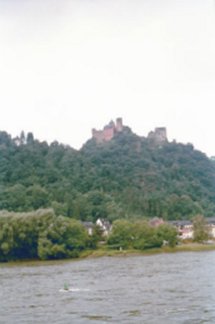 |
Rhine Revisited by Gregory E Bandlow
A little farther downstream but still within the view of Kaub, lies the
little town of Oberwesel snuggled into a little opening in the Rhine
Valley. Surrounded by gently slopes and vineyards, the town is very proud
of its tower defenses and very proud of its name. Oberwesel translated means
"town of many towers and wines. High above Oberwesel and silhouetted against
the sky, is the majestic, thousand year old Schonberg castle which keeps watch
over the town. At one time it was the possession of the Counts of van Stahleck
whose castle we encountered earlier on our voyage, Schonberg castle was given
in 1166 by Friedrich 1 (Barbarossa) to one of his imperial officials. He and
his descendants from then on called themselves von Schonberg after the name
of their residence.

|
Schonberg Castle and the custom duties collected in Oberwesel made Schonberg
castle and its owners one of the most powerful and richest families in
the region. Schonberg remained in the same family until it was destroyed
by King Louis XVI of France. In 1885 its owners has the castle partially
rebuilt . Today one half of the castle is a hotel and the other half is
a Youth Hostel.
The town of Oberwesel is situated on the site of an ancient Celtic settlement,
which later became a Roman military service point. In 1237 Schonberg Castle became
the property of the Emperor alone, and Oberwesel formerly known as Wesel,
was able to pay 300 marks in silver and thus rid itself of the Schonberg rule.
It was in this way that Oberwesel became a fee imperial city. In the following years
a wall was built around the city. Most medieval cities had walls. With 18
towers, it is the most complete medieval city wall still standing in the
whole Middle Rhine area. The walls of the city are massive and the towers
besides the Rhine, the Ochsenturm (Oxen Tower) and the Haagstrum are worth seeing.
It was here that my father was said to have crossed. Yet, as we had no idea exactly where, we devised a plan so as not to miss that spot. I had my camera at the ready and I gave my oldest daughter Jessica a portable camera that I had purchased just the night before for this occasion. I was going to take pictures down one side of the river and I instructed her to take pictures down the other side. We wanted to give our Opa a clear picture of the way the river looked. It never did occur to us that he probably saw very little that night in 1945. I would think it is extremely difficult sight seeing in the night, let alone when someone is shooting at you. We were very much on the lookout for a railroad tunnel. My farther had told me that the Germans had set up an artillery piece in a railroad tunnel and that this gun had raised hell with them at the time of their crossing. As our boat plied its way downstream we strained our eyes looking for the railroad tunnel and tried to take as many pictures of the town of Oberwesel as we could. I glanced back toward Kaub. Was this where he had crossed, or was it still up ahead. We had never discussed Schonberg. Yet, Schonberg seemed to be part of Oberwesel. I was confused, which is nothing new for me. I kept remembering the railroad tunnel, so I only shot one picture back towards Kaub and looked ahead for the railroad tunnel.
Then up ahead in the distance I thought I could make out a tunnel. Yes, it was a tunnel, but was it the tunnel we searched for?
Previous | Next
|
 |

